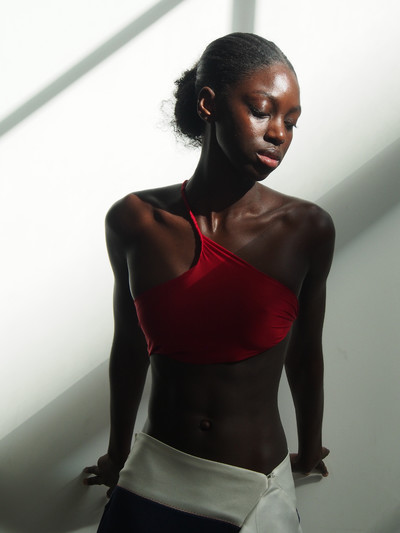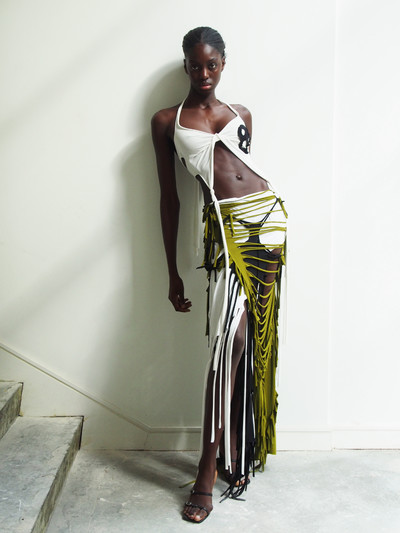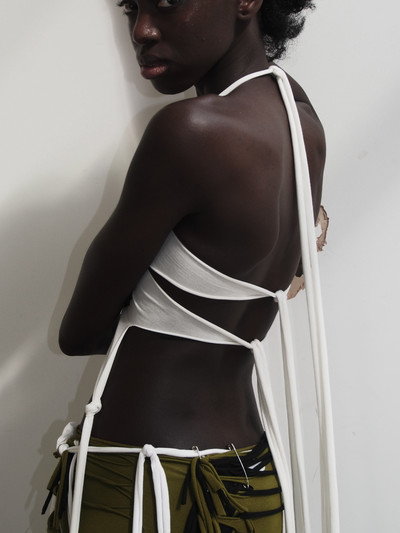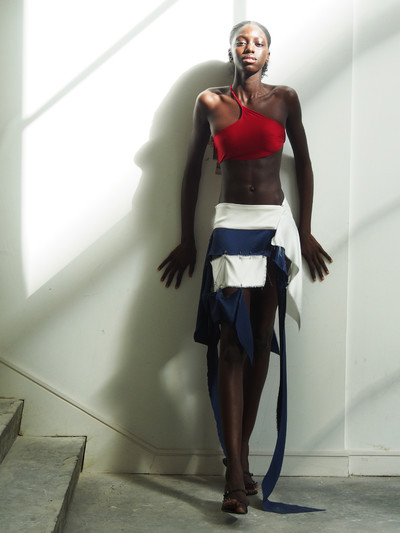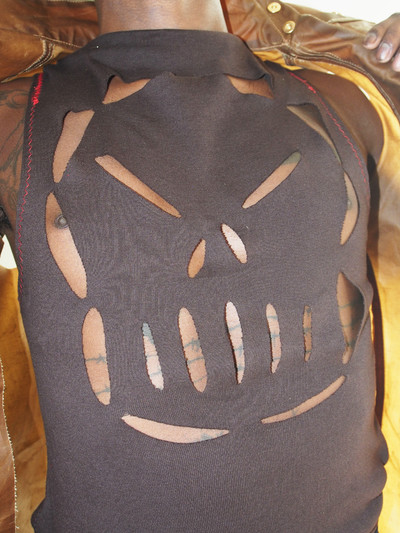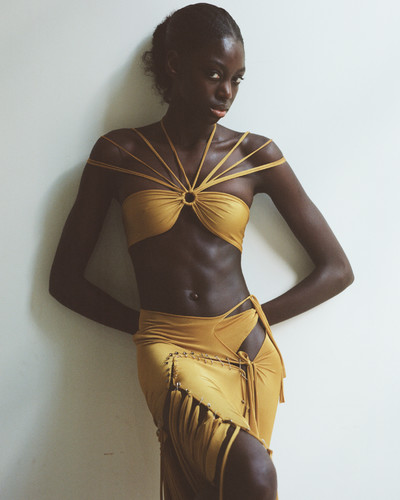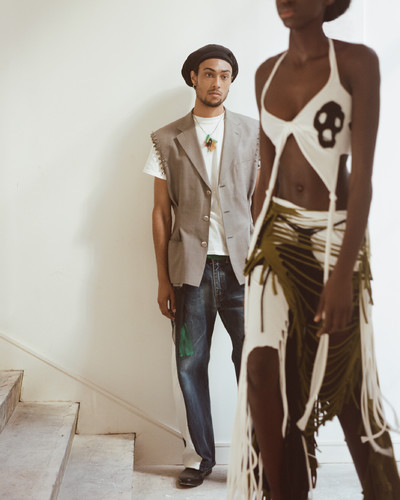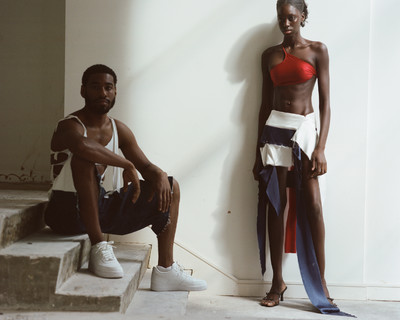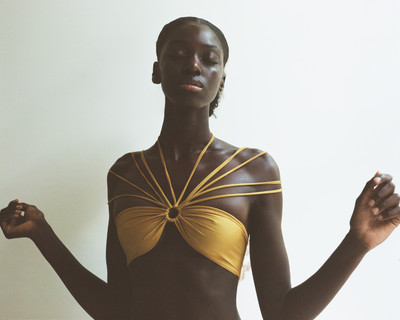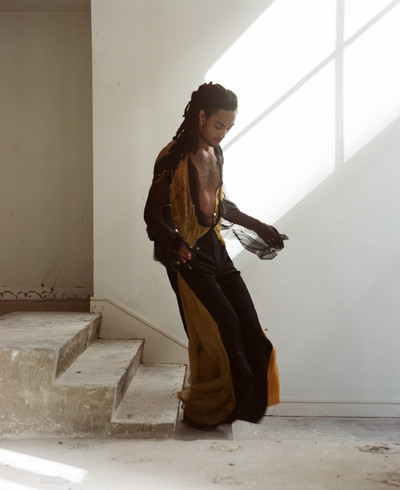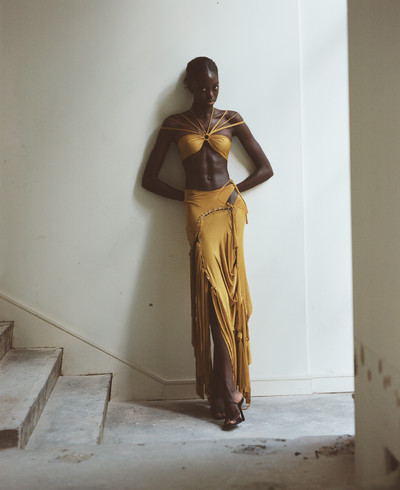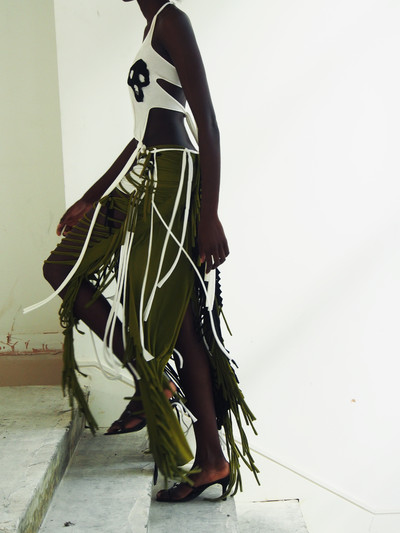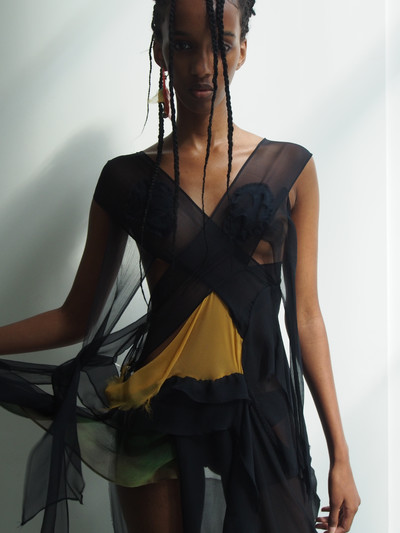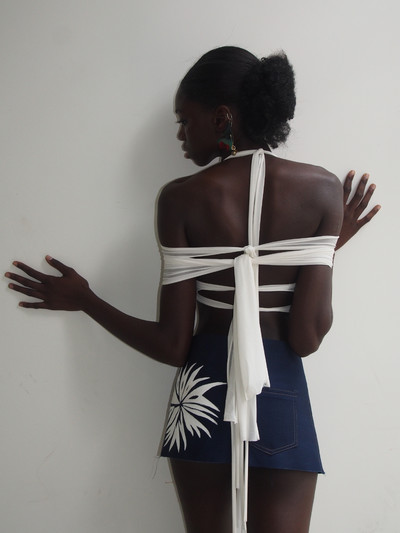Shipwreck, subculture and safety pins – introducing Jawara Alleyne’s New World order through culture combining, rather than culture clashing.
By Rahim Attarzadeh
Photographs by Anna Victoria Best
Styling by Marika-Ella Ames
Shipwreck, subculture and safety pins – introducing Jawara Alleyne’s New World order through culture combining, rather than culture clashing.
‘As I develop, I want to present a balanced axis between the fantasy and reality of who I think I am.’ Since graduating from Central Saint Martins’ MA Fashion course (menswear) in 2020, London-based designer Jawara Alleyne has utilised his experiences growing up between Jamaica and the Cayman Islands to maximum sartorial effect. His namesake label threads the safety out of the safety pin, breaking down any conventions of what can be perceived as normal methods of cutting and splicing fabric, fashion and fantasy, making Alleyne one of the most enterprising designers to show at London Fashion Week in years.
Despite releasing his first official collection at the mere age of 16 and showing abroad at Lagos fashion circuits’ ARISE in 2020, Alleyne has found domesticity in London’s innovative, inspirational and inimitable mainstream through revered incubator Fashion East. Since his Autumn/Winter 2021 debut and his now-graduate collection for Spring/Summer 2023, each offering has honed Alleyne’s vision for a new world order.
New World presents an off-kilter dream meets reality, tapping into Alleyne’s otherworldly tapestry of influences. Pirates, punks, carnival enthusiasts and new romantics all form the aesthetic breeding ground and four corners of Alleyne’s mind’s eye. Draping silhouettes, slashed to the thigh skirts and vibrant colour combinations from the designers Cayman and Jamaica roots met with fervently and punkishly noir London-induced staples assemble the building blocks of Alleyne’s SS23 collection. Safety pinned and pinched blazers and sensational denim iterations paired with studded leather take cues from America’s Hardcore and Britain’s Rock n Roll subcultures, thus revealing the designers seemingly-obsessive relationship with vintage and creating newness that already feels truly lived in. ‘I’ve developed this coming from Jamaica. It’s innate for me. Everything over there is so aged, but rich and you can see that life has been lived to its fullest,’ reveals Alleyne.
System caught up with Fashion East’s most recent graduate to discuss his relationship with subculture, the autonomy of conception versus convention and using the language of fashion to challenge every kind of stereotype.
Coming from Jamaica and the Cayman Islands, how important have your roots been in developing your rich understanding of colour and texture? Has the contrast between the two influenced your own personal aesthetic and how that has subsequently affected your approach to design since moving to London? London-based designers, similarly to Japanese designers, seem to reveal personal, yet discrete nuances about themselves through their collections. Would you say that is accurate for you?
Jawara Alleyne: Coming from those two places, they are both so different in the way in which colours play out in each society. Both the Caymans and Jamaica have a strong resonance with colour. In the Cayman Islands, everything is very clean and sharp and to the tee. People from there like to wear a lot of pastel colours. Whereas, in Jamaica, it’s a lot more deep and dusty and gritty. Jamaicans don’t like clean colours. Everything feels almost sunburned. Growing up between those two places and living somewhere completely different like London has given me my own point of view in terms of my personal style. Whilst I do appreciate the clean, tailored looks I grew up with in the Caymans, I know I’m just not that way inclined! London has brought out that tendency I have to construct something really off-kilter and hone a signature aesthetic.
Your approach is heavily influenced by vintage. When did your relationship with vintage start becoming the foundations of a Jawara Alleyne collection?
Jawara Alleyne: Whilst I’ve always been interested in vintage, it really comes from the fact that in the islands, we have a culture of hand-me-downs. My relationship with old clothes exists because they were always around me. Then moving to London and seeing how vintage was a way of relating clothing to exist in a fashion space, or collection space brought out that culture more creatively.
Being able to have an honest relationship with the past, through history has allowed me to understand clothing as cultural artefacts, all of which represent different stylistic eras. Currently where we are in the industry, designers can’t ignore items that have existed in the past through the history of fashion. Even if you’re not a designer who upcycles and reworks deadstock, or vintage clothing, you really have to be cognizant of the histories and nuances of garments that existed beforehand. If we were to sit down and consider what the future holds for emerging designers, we’d immediately look at the past to consider that future.
‘I don’t use conventional methods of construction just because that’s how you make clothes. I want to challenge convention and creation through conception.’
When did you start getting interested in subculture and image? You’ve recontextualised garments such as Jun Takahashi Undercover t-shirts as well as vintage comic book (Batman) and memorabilia (Hard Rock Cafe) t-shirts. What was your gateway into subculture and was it born out of a sense of restriction you experienced in your youth?
Jawara Alleyne: Aah, you’ve seen it! My gateway into subculture coming from an island was virtually non-existent as it didn’t really exist over there. We just didn’t really have subcultures. We barely even had culture in the Cayman Islands! It’s such a small place. We didn’t have these places where we could just go and hang out, or experience any form of youth culture. My calling towards subculture came from being on the internet, where you still had MSN. That’s where subculture lived for me. I’d be on these group chats talking about a particular film or record. The only thing we had that you can see in my work is the Hard Rock Cafe. It was the only place where you could buy iconic merchandise at the time. Their commercial, or ‘iconography-esque’ status really drew me towards memorabilia and streetwear points of view. Items that can have a permanent belonging through iconography have always been important to me. My interest in London style comes from my underlying interest in subculture.
Let’s talk about your latest SS23 collection. It’s called New World. Can you talk me through the references, themes and motifs?
Jawara Alleyne: For the New World collection, I wrote this story of a pirate ship crashing into a yacht. It’s a metaphor of my origins. On one hand the pirate signifies the setting of the story which I set the collection in. All of the characters I presented through the clothing were part of this scene. The metaphor comes in because the idea of a pirate ship crashing into a yacht considers my culture for setting a tone in communicating what is actually going on in the Cayman Islands. It’s an area that is quickly developing, but not for the people who actually live there and who are from there. More so for tourism. The crash symbolises a meeting, or culture-clash of these two worlds. Punk and Reggae culture, Carnival culture and the Pirate culture in the Islands all collide to create this multifaceted point of view. As a creative who has grown up in both worlds and then coming to Lonon has brought this notion of combining all of these elements together, with their own grunge and punk intellect. New World is a collision of all the cultural components I find interesting and have naturally gravitated towards.
‘If everyone in the industry shared the same opinion, then real change becomes a probability, instead of a possibility.’
The collection consists of clothes cut and spliced using now-iconic symbols of British punk and creativity born out of necessity such as safety pins. The deconstruct to reconstruct effect – is this modus operandi something you have developed consciously, or subconsciously throughout your designs? How do the garments materialise from conception to creation?
Jawara Alleyne: I think it came to me subconsciously. I’ve always worked in this way, where I’ve kept everything I’ve collected, such as safety pins, since I was a kid. It goes back to what I was saying earlier about the hand-me-down culture I grew up with. I then transitioned from the ability to use a safety pin just to make something work into an item of embellishment and creativity, instead of its inherent functionality. I never liked safety pins for their traditional purposes. I don’t think things should always be seen as exactly what they need to be in order to serve a function. I never trusted that point of view. It’s not challenging. I learned how to sew and make clothes but I don’t use conventional methods of construction just because that’s how you make clothes. I want to challenge convention and creation through conception.
Would you say your process is underscored by an urge, or obsessive compulsion towards constructing and layering garments that are unfinished, or imperfect? Do you see beauty where others find flaws?
Jawara Alleyne: It’s exactly that. I think things that are flawed and imperfect are so beautiful. I think I’ve developed this coming from Jamaica. It’s innate for me. Everything over there is so aged, but rich and you can see that life has been lived to its fullest. A lot of the references and resources that I look into are these things that have transformed and transcended through time. You know these items have been lived in because of beauty through ageing. In many ways, I reject things that feel too fresh. I think most of us do - we gravitate towards things that feel like they’ve lived a life because there’s an element of its materialism we are interested in. I always strive to show that effect through my clothes.
What do you want your ethnicity to reveal about your approach to design? Could fashion be a vehicle for you to challenge any preconceived notions of cultural stereotyping through radical and reinventive designs and in-turn challenge how you see yourself?
Jawara Alleyne: Definitely. We were talking about this in the studio the other day in that fashion is one of the only points of view that asks human beings to reveal something about themselves through their work. It has been an outlet for me to question who I am and how I want to operate in this industry. As I develop, I want to present a balanced axis between the fantasy and reality of who I think I am. Fashion allows you to have conversations that you can’t necessarily have in other aspects of society. It forces you to think about yourself and to place yourself in a different context. Fashion allows me to challenge those stereotypes around my culture, because they really exist and they aren’t just exclusive to my own experiences and background. It’s a way of seeing the world through a more optimistic and hopeful lens, yet still being aware of the challenges surrounding this. I want my designs to tell my story but not because it’s about me. I’m telling the story of a bigger body of people who struggle with identity and stereotyping.
I read that over the summer you stepped out of London’s fashion circuit and hosted a summer camp for teenagers in The Cayman Islands. How important is the nurturing of a creative community in your hometown in relation to your own career aspirations and dreams?
Jawara Alleyne: Extremely important. I owe it to my community to support their dreams as much as I can because I came from that same place. It’s even harder to pursue the arts in the Caymans nowadays compared to when I grew up there. It should technically be easier. There were a lot more programmes that valued art and creativity when I was growing up and there were key people on the island who really fought for the importance of that. I don’t think it’s a small island problem however. Generally, creativity has suffered all over the world and it’s taken a backseat in terms of gaining financial support compared to the more ‘conventional’ industries. Fewer people fight for creativity and a decent arts programme in schools and education. As I come from a place where I was fortunate enough to have good access to these programs, it created a value system in me, where I want to give back to the kids who don’t have that same opportunity.
‘That’s what I’m trying to present in my work. It’s an honest view of how masculinity isn’t defined by how you look.’
Do you believe that fostering a community within one’s hometown has the power to affect real change within the industry worldwide?
Jawara Alleyne: It’s imperative if you want to be the change you seek to inspire. I can do it in my hometown because it’s on a much smaller scale, but we should be doing the same thing in London and all those other cultural capitals. Access to everything is currently more difficult post both Brexit and Covid so we need to communicate in ways that make the industry an actual industry and not just a competition. I think the industry forgets that sometimes you live on the same street as other people you could be working with, or you speak the same language, so we need to be encouraging the notions of community and collaboration. It all starts from building that around your own space before expanding. If everyone in the industry shared the same opinion, then real change becomes a probability, instead of a possibility.
I want to finish on a question about masculinity and identity because it’s at the core of your work. The subversion of stereotypes surrounding masculinity are recurring themes within your collections. What do you want your work to reveal about perceptions, or misperceptions of masculinity?
Jawara Alleyne: For me, masculinity is not something we hold just as men. The same could be said about femininity. The way I see it is that masculinity is not something that’s defined by your gender at all. It’s not something you can impose on anyone. It’s really just about how you feel. Within my work, it’s a reflection of the men I experienced growing up in the islands. The men over there wear a lot of colour and that is considered extremely masculine. I come from a place that’s very homophobic and that has weaved these false ideologies of masculinity throughout the islands. However, at the same time, I grew up around figures that were so feminine, and soft, and jovial, and humorous, and expressed themselves in such an honest way that we discarded masculinity all together. That’s what I’m trying to present in my work. It’s an honest view of how masculinity isn’t defined by how you look.
Make-Up Artist: Janina Zais. Casting Director: Theo Spencer. Models: Tafari Alleyne, Kodou Charrier @The Hive. Nadah Abdulle @Elite. Stanley Bryan @ Models 1. Joseph Jacob @First Model Management. Special thanks to: Fashion East, CEBE Studio, RAVEN.

